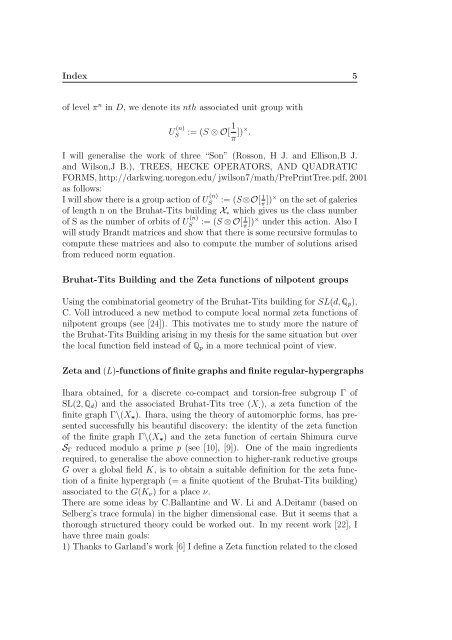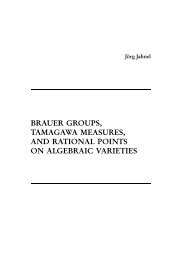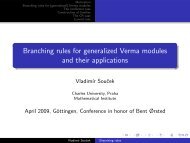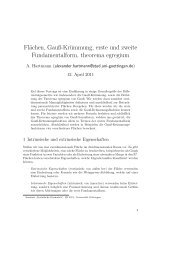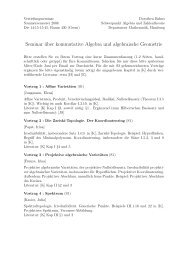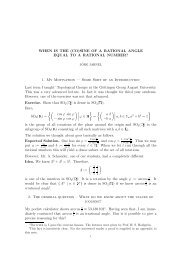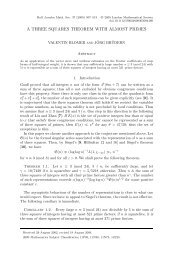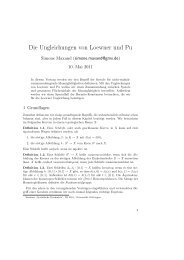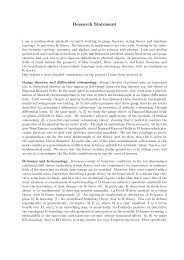Teaching Statement and Statement of Research Plans - GWDG
Teaching Statement and Statement of Research Plans - GWDG
Teaching Statement and Statement of Research Plans - GWDG
Create successful ePaper yourself
Turn your PDF publications into a flip-book with our unique Google optimized e-Paper software.
Index 5<br />
<strong>of</strong> level π n in D, we denote its nth associated unit group with<br />
U (n)<br />
S<br />
:= (S ⊗ O[ 1 π ])× .<br />
I will generalise the work <strong>of</strong> three “Son” (Rosson, H J. <strong>and</strong> Ellison,B J.<br />
<strong>and</strong> Wilson,J B.), TREES, HECKE OPERATORS, AND QUADRATIC<br />
FORMS, http://darkwing.uoregon.edu/ jwilson7/math/PrePrintTree.pdf, 2001<br />
as follows:<br />
I will show there is a group action <strong>of</strong> U (n)<br />
S<br />
:= (S ⊗O[ 1 π ])× on the set <strong>of</strong> galeries<br />
<strong>of</strong> length n on the Bruhat-Tits building X ∗ which gives us the class number<br />
<strong>of</strong> S as the number <strong>of</strong> orbits <strong>of</strong> U (n)<br />
S<br />
:= (S ⊗ O[ 1 π ])× under this action. Also I<br />
will study Br<strong>and</strong>t matrices <strong>and</strong> show that there is some recursive formulas to<br />
compute these matrices <strong>and</strong> also to compute the number <strong>of</strong> solutions arised<br />
from reduced norm equation.<br />
Bruhat-Tits Building <strong>and</strong> the Zeta functions <strong>of</strong> nilpotent groups<br />
Using the combinatorial geometry <strong>of</strong> the Bruhat-Tits building for SL(d,Q p ),<br />
C. Voll introduced a new method to compute local normal zeta functions <strong>of</strong><br />
nilpotent groups (see [24]). This motivates me to study more the nature <strong>of</strong><br />
the Bruhat-Tits Building arising in my thesis for the same situation but over<br />
the local function field instead <strong>of</strong> Q p in a more technical point <strong>of</strong> view.<br />
Zeta <strong>and</strong> (L)-functions <strong>of</strong> finite graphs <strong>and</strong> finite regular-hypergraphs<br />
Ihara obtained, for a discrete co-compact <strong>and</strong> torsion-free subgroup Γ <strong>of</strong><br />
SL(2,Q d ) <strong>and</strong> the associated Bruhat-Tits tree (X . ), a zeta function <strong>of</strong> the<br />
finite graph Γ\(X ∗ ). Ihara, using the theory <strong>of</strong> automorphic forms, has presented<br />
successfully his beautiful discovery: the identity <strong>of</strong> the zeta function<br />
<strong>of</strong> the finite graph Γ\(X ∗ ) <strong>and</strong> the zeta function <strong>of</strong> certain Shimura curve<br />
S Γ reduced modulo a prime p (see [10], [9]). One <strong>of</strong> the main ingredients<br />
required, to generalise the above connection to higher-rank reductive groups<br />
G over a global field K, is to obtain a suitable definition for the zeta function<br />
<strong>of</strong> a finite hypergraph (= a finite quotient <strong>of</strong> the Bruhat-Tits building)<br />
associated to the G(K ν ) for a place ν.<br />
There are some ideas by C.Ballantine <strong>and</strong> W. Li <strong>and</strong> A.Deitamr (based on<br />
Selberg’s trace formula) in the higher dimensional case. But it seems that a<br />
thorough structured theory could be worked out. In my recent work [22], I<br />
have three main goals:<br />
1) Thanks to Garl<strong>and</strong>’s work [6] I define a Zeta function related to the closed


